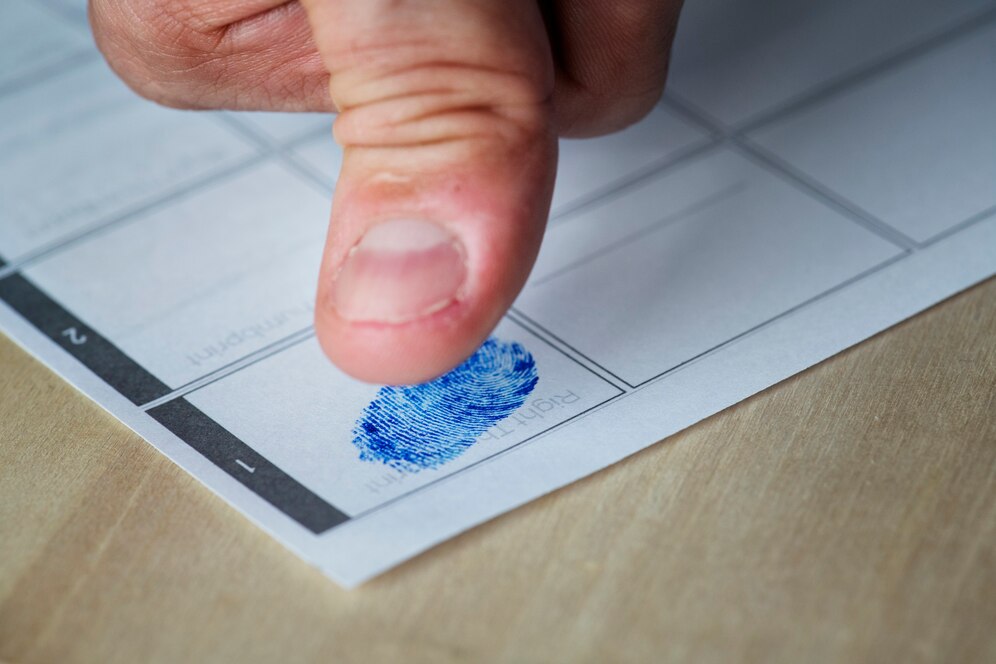- info@clueshieldforensic.com
- Open Hours: Mon - Sat 10.00 am - 7.00 pm
Fingerprint Development & Examination
Fingerprint analysis and examination play pivotal roles in forensic investigations and law enforcement. This scientific discipline involves the systematic study of unique ridge patterns and characteristics found on the fingertips.
Forensic experts utilize specialized techniques to collect, preserve, and analyze fingerprints left at crime scenes. These techniques may include powder dusting, chemical treatments, or the use of alternate light sources to reveal latent prints.
The examination of fingerprints involves comparing the patterns, ridges, and minutiae - the tiny ridge characteristics unique to each print. By analyzing these features, forensic analysts can identify and match fingerprints to individuals, aiding in criminal identification and investigation.
Fingerprint analysis is highly reliable due to the permanence and uniqueness of fingerprint patterns. It serves as a cornerstone of forensic science, providing crucial evidence in solving crimes and identifying suspects.
- Uniqueness of Fingerprints: Fingerprint patterns on the first phalange of fingertips, as documented by Kumar (2014) and Sugiura & Koseki (1998), are inherently unique, varying from person to person. This uniqueness remains unchanged throughout an individual's life, serving as a distinctive identifier. Duplication of fingerprints has never been observed, emphasizing their role in maintaining individuality.
- Permanence of Fingerprints: Fingerprint ridges, appearing before birth typically during the third or fourth month of pregnancy, persist as a constant feature throughout an individual's lifetime and beyond death. They serve as a natural and unchanging form of identification, akin to an innate identity card.
- Universal Identification: Berry et al. (2001) highlight fingerprints as a universal medium of identification, present in all individuals worldwide. Criminals often leave fingerprints at crime scenes, making them a universal tool for forensic investigations.
- Inimitability of Fingerprints: Despite attempts at imitation, successful replication of fingerprints has not been reported. Expert forensic analysts can easily detect forgeries, underscoring the inimitable nature of fingerprint patterns.

- Classifiability of Fingerprints: Fingerprints possess unique ridge characteristics and patterns, facilitating their systematic classification by experts in forensic analysis.
- Uniqueness in Twins: Even identical twins, sharing the same genetics, exhibit unique fingerprint patterns, enabling their differentiation through fingerprint analysis.
- Identification of Identical Fingerprints: When experts declare two fingerprints as identical, it indicates that both share the same pattern and similar ridge characteristics, known as minutiae. These minutiae serve as crucial identifiers in forensic investigations.
- Latent Fingerprints: Also known as hidden prints, latent fingerprints are developed by forensic experts at crime scenes using methods such as powder application, chemical treatment, or alternate light sources, providing valuable evidence in criminal investigations.
Physical Fingerprint Examination:
The physical fingerprint method is a fundamental technique used in forensic science for identifying individuals based on unique patterns found on their fingertips. This method involves the direct physical comparison of fingerprint impressions collected from crime scenes or objects of interest.
- Collection Process:Fingerprint impressions can be collected using various methods, including ink and paper, adhesive tape, or digital scanners. Each method captures the intricate ridge patterns and minutiae unique to each individual.
- Analysis and Comparison: Forensic experts analyze collected fingerprint impressions using specialized tools and techniques. They meticulously compare the patterns, ridges, and minutiae of latent prints to known reference prints, such as those from databases or individuals with previous records.
- Identification and Matching: The goal of the physical fingerprint method is to accurately identify and match latent prints to individuals. A positive match provides valuable evidence for linking suspects to crime scenes or objects, aiding in criminal investigations and legal proceedings.
Chemical Fingerprint Method:
The chemical fingerprint method is a vital technique in forensic science used to reveal latent fingerprints by enhancing their visibility through chemical processes. This method is employed when traditional physical methods, such as powder dusting or adhesive lifting, are ineffective at detecting latent prints.
- Principles of Chemical Enhancement: Chemical enhancement techniques exploit the chemical properties of fingerprint residues, such as oils, sweat, and amino acids, to make latent prints more visible. These techniques aim to increase the contrast between the fingerprint ridges and the background surface.
- Types of Chemical Enhancement: Several chemical methods are used to enhance latent fingerprints, including:
- Ninhydrin: Ninhydrin reacts with amino acids present in fingerprint residues, producing a purple or pink coloration on treated surfaces.
- DFO (1,8-Diazafluoren-9-one): DFO is a fluorescent dye that selectively binds to the components of latent prints, allowing for visualization under alternate light sources such as lasers or ultraviolet (UV) light.
- Cyanoacrylate Fuming: Cyanoacrylate fuming involves exposing fingerprint residues to cyanoacrylate vapors, which polymerize and adhere to the moisture in the prints, creating a white, visible deposit.
- Application and Analysis: Forensic experts apply chemical enhancement techniques to surfaces suspected of containing latent fingerprints. After treatment, the enhanced prints are examined visually or with specialized equipment to identify ridge patterns and minutiae for comparison and analysis
- Data Storage Challenges: There's no guarantee that stored data will always contain the specific print investigators are seeking, leading to potential challenges in matching fingerprints to individuals.
- Weather Dependence of Latent Prints: Latent prints can be significantly affected by weather conditions. In hot weather, prints may be obscured by perspiration, while in cold conditions, there may be less moisture, resulting in less distinct prints. Factors such as rain and wind can further impact the condition of latent prints.
- Issues with Powder Method Development: When using the powder method to develop latent prints, there's a risk of the powder bunching up and obscuring ridge details, potentially complicating the examination process.
- Inability to Determine Print Age: It's often impossible to determine when a latent print was first left on a surface. Under optimal conditions, prints can persist indefinitely, making it challenging to establish a timeline for their deposition.
